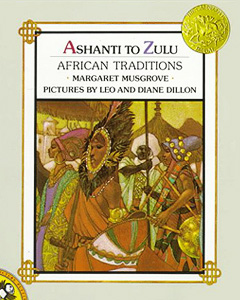MODULE 3:
ASHANTI TO ZULU:
AFRICAN TRADITIONS
by Margaret Musgrove,
Illustrations by Leo and Diane Dillon
Musgrove, M. (1976). Ashanti to Zulu: African Traditions. New York: Dial Books for Young Readers.
Ashanti to Zulu is an interesting book in that it doesn't tell a story but instead is educational while simultaneously being highly entertaining. It goes through every letter of the alphabet to give brief information of twenty-six distinct African people. Each ethnic group is illustrated with figures that show them in traditional dress.
 Each blurb has the group's name provided with the phonetic pronunciation. For example, the Quimbande have next to their name this: (keem-bahn-deh). Each section tells something unique about the group. For example, the Quimbande believe in polygamy, where "children can have as many as twenty-five brothers and sisters if their father can afford them". The Tuareg (twah-reg) people, for their part, have the men wear veils while the women, unveiled, are the more verbal of the two with the men sitting quietly as the women converse.
Each blurb has the group's name provided with the phonetic pronunciation. For example, the Quimbande have next to their name this: (keem-bahn-deh). Each section tells something unique about the group. For example, the Quimbande believe in polygamy, where "children can have as many as twenty-five brothers and sisters if their father can afford them". The Tuareg (twah-reg) people, for their part, have the men wear veils while the women, unveiled, are the more verbal of the two with the men sitting quietly as the women converse.In terms of story, there is none. Nothing ties one ethnic group to the other. They never meet and they are so varied that the Masai and the Xhosa would not sense a similarity in their worlds. Instead, Ashanti to Zulu gives us a fascinating look into the variety of African cultures. From Ashanti to Zulu instead has as its purpose to give information on each group, which while brief is still highly interesting. Some, like the Baulle, give us a legend about the group (how they were saved from the enemy by crocodiles in exchange for their most precious object, which in this case was the queen's only son. Others, like the Lozi, as a people move to higher ground when the Zambezi River floods; the Royal Ship called the Nalikwanda leads all other ships that contain not just the people but stoves and even cows.
Ashanti to Zulu I think makes learning about the various peoples of Africa interesting due to the brevity of the text for each group as well as due to the beautiful illustrations. The Dillons add rich details to each drawings. For example, the desert people's illustrations are dominated by shades of yellow to reflect their world. Those in the more lush parts are more green.
Granted, Ashanti to Zulu is more educational than entertaining, which makes it a rarity among Caldecott winners in that it doesn't tell a specific story. A child, though, I believe will find it interesting not just because we see a wide variety of African people but because the illustrations are so well-done and because the information is brief.
BRIEF REVIEW DISCUSSION
The Kirkus Review was quite harsh on Ashanti to Zulu. "This prescribed format gives a superficial air of sameness to the pictures even though the Dillons are careful to depict differences in headdress, dwelling structure, etc., and it gives the pages a static, stilted look which the illustrators do nothing to allay." I can see the review has a point: there is no variation to the style both in text and illustrations (though the illustrations are very lavish). I don't think, thought, that Ashanti to Zulu that it was meant to be a deep exploration of various African cultures. I think the reviewer missed the points of Ashanti to Zulu: to serve as an unofficial introduction to the alphabet (in the same way A is for Apple, or A is for A if you're an Ayn Rand follower), and as a primer on the distinct African cultures. Ashanti to Zulu is meant to just touch on the cultures, presenting tidbits to young readers and give them beautiful illustrations to look at. I think the illustrations bring elegance and dignity to their subjects (which I think most fitting). I also think children, at this stage, welcome repetition. It creates a steady pace that they can follow without worrying about change. In that respect, Ashanti to Zulu is a great success, one that I would happily read to my child.
PROGRAMMING IDEAS
A wonderful opportunity to use Ashanti to Zulu would be during any Black History Month presentation. You could offer an African face mask competition/program, invite African dance troupes (if available) to perform, or invite children to create their own stories around one of the 26 nations presented in the book. You may even have a storyteller present traditional African tales to children or adults.
REFERENCES:
Book Review: Ashanti to Zulu: African Traditions by Margaret Musgrove. Kirkus Reviews. Retrieved from https://www.kirkusreviews.com/book-reviews/margaret-musgrove-2/ashanti-to-zulu-african-traditions/


No comments:
Post a Comment